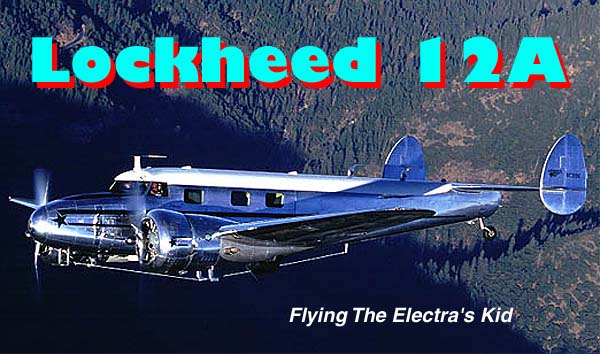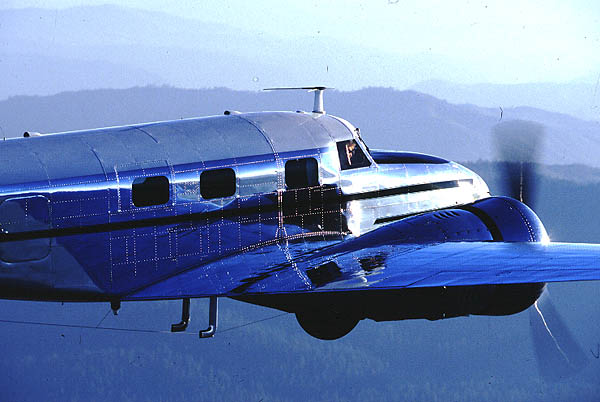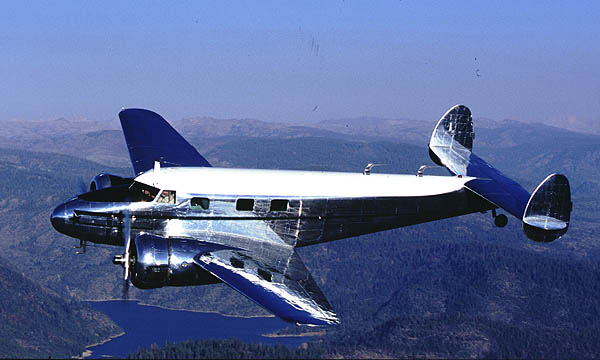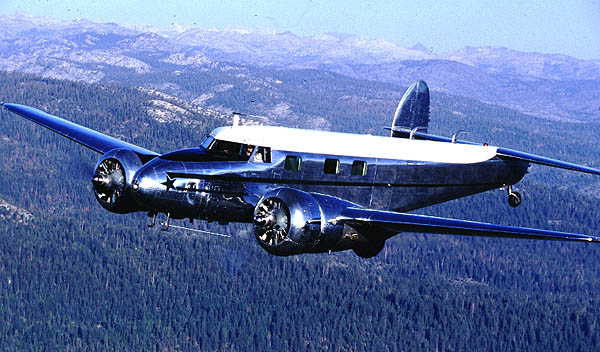

Editor's note: Although the text addresses a Lockheed 12A owned by Lou Helton at the time of the article (1989), all photos are of Kent and Sandy Blankenberg's airplane based at Grove, California. We thank them mightly for the fine flying and even better friendship.
As the landing gear was cycling up, Lou Hilton reached over and threw a swtich that momentarily pumped electricity into the landing gear indicator lights. With the "up" lights lit, he flipped the switch off and the lights went out. It was obvious that we had just reached across time into the Gold Age of aviation. This curious switching procedure reminded us that this marvelous aluminum mini-liner, the Lockheed 12A Electra Jr, sleek thought she may be, was nonetheless an anachronistic survivor from a time when things were truly happening in the world of aviation. It was a time when,even something as simple as a gear indicator light represented the cutting edge of technology.
Although many will debate the exact time frame, it's hard to debate the fact that the decade from 1930 to 1940 is the only one was in aviation history which saw incredible advances being made without the technological acceleration of war. The military began the decade with the Hawk series of Curtis biplanes and finished it with P-38's, P-40's etc. Hulking fabric biplanes like Travelairs and WACO's gave way to Cessna Airmasters and then Spartan Executives. Airline passengers didn't even have time to get used to plodding cross country in Ford Trimotors and Curtis Condors before they were replaced by Boeing 247s and DC-2/3's. It was a truly exciting time in which aviation entered the decade in a slow walk and exited in a full-developed gallop.
Central to the 1930's theme of expansion and endless technological advances was Lockheed and its famous Electra series.
Like many manufacturers, Lockheed began the "Golden Decade" with one type of product but exploded into a giant company with an ever-expanding line of airplanes. Lockheed airplanes first gained fame in the bands of pilots like Wiley Post, who took the rotund, wooden Vega and set records for speed, altitude and distance over every corner of the globe. When the first of the Electra series came out, the 10A, it was a slim young girl with a rich publisher husband who made the Lockheed series a household word. Of course it could be argued: Did Amelia Earhart make the Electra famous or was it vice versa?
 In the early 1930s, the federal
government was actively engaged in expanding and developing the
fledgling airline industry. In 1934 it pushed for the replacement
of all single-engine aircraft being used for scheduled service
by twin-engine machines. This ruling worked right into Lockheed's
hands, since they had already designed the Electra with that market
in mind. The government found (and they are still finding) that
to make a major airline system work you had to be able to feed
passengers into central hub locations using smaller airplanes.
But the DC-2, 247 and Lockheed 10 didn't fit their definition
of a smaller airplane. Therefore, they put out an invitation for
companies to submit twin-engine designs more suitable to the feeder-line
concept.
In the early 1930s, the federal
government was actively engaged in expanding and developing the
fledgling airline industry. In 1934 it pushed for the replacement
of all single-engine aircraft being used for scheduled service
by twin-engine machines. This ruling worked right into Lockheed's
hands, since they had already designed the Electra with that market
in mind. The government found (and they are still finding) that
to make a major airline system work you had to be able to feed
passengers into central hub locations using smaller airplanes.
But the DC-2, 247 and Lockheed 10 didn't fit their definition
of a smaller airplane. Therefore, they put out an invitation for
companies to submit twin-engine designs more suitable to the feeder-line
concept.
Again, the fates had worked to Lockheed's favor, since they had earlier decided the Model 10 was too big for corporate use and had begun design on a smaller airplane using the same two 450 hp P&W radials. Their reasoning was simple: Hang a smaller airplane behind the same power package and you'd have a quantum jump in performance at the cost of a few seats. Their timing was perfect. The government had stipulated that they wouldn't consider an airplane that had flown for the first time after 30 June 1936. The Electra Jr. put daylight under its wheels for the first time just three days before the deadline!
The 12A was truly a piece of high-performance hardware. At least the original specification sheets make it look that way. Its top speed was 225 mph and it cruised at 213 mph. This was in fact, faster than most of the Army Air Corps first line fighters could muster. In theory, it could run away and hide from most of the Air Corps, since much of the force consisted of aging biplanes.
Every effort was made to keep the frontal area low and the lines long, which resulted in the unmistakable slot-like windshield and long, long, almost feminine lines of the fuselage. The airplane is, unfortunately, most often confused for the much more common Twin Beech. If the two are parked together, the rocket-like proportions of the 12A are instantly apparent.
Although designed as a feeder airplane, very few of the airplanes were ever used for that purpose. Its greatest use came as a corporate transport or government utility bird-and the Netherlands East Indies government turned out to be the biggest user when they purchased thirty-six of the original production of about 125 airplanes.

Probably the most colorful chapter in Lockheed 12 history comes under the heading of "Sydney Cotton: Volunteer Spy." Cotton was an Australian-born pilot who did most of his flying in Europe during the increasingly dark days in 1939-40. It isn't known for sure whether his activities were initiated by the English government or whether he took it upon himself and was later conscripted by the government. Either way he did Her Majesty some very serious favors. He outfitted a Lockheed 12A as a camera ship and proceeded to criss-cross all of Europe, especially Germany and Italy, taking aerial photos of all of their military installations. He carried as many as six cameras on board (in secret compartments), four of which were the fixed mapping type cameras that should have given the guys at 10 Downing Street some great snapshots for their collection. Cotton's pictures of his summer vacation probably saved thousands of lives.
As with most civilian airplanes of the time, the vast majority of the Lockheed 12s were eventually impressed into military service and the last two years of 12A production was almost exclusively for government agencies. One of these airplanes was Lockheed 12A construction number s/n 1277.
The marvelous thing about airplanes is a great many of them grow to a very ripe old age and because of the tangled paperwork pedigree attached to each of them, it is possible to relive their travels through logbooks and assorted documents. In the case of s/n 1277, she was horn in 1939 but was taken over by the Treasury Department in 1941 where she became part of a Lend-Lease package headed for England. Wearing RAF colors she performed the usual liaison and utility roles for the duration and undoubtedly did so very well.
Cashiered out of the service in 1945, s/n 1277 worked for a variety of English and French owners before coming into the hands of one Monsieur Chapeau who was operating a short haul airline in France. The date was 1962 and for the next twenty years, s/n 1277 earned her living hauling freight and passengers to such exotic locales as Tangier.
In 1982 the French government reportedly began to hassle Mr. Chapeau simply because he was seventy-eight-years old and was still the chief pilot! As would be expected from a man who was able to make a living from one of the most difficult livelihoods known, he wasn't about to sit on the ground while other pilots helped him make money: Chapeau thumbed his nose at the French authorities and simply shut down the entire operation. Mr. Chapeau was operating three or four of the Lockheeds, which came to the immediate attention of a noted French aviation buff who purchased all of the assets of the airline. Then, Lou Hilton of Greenville, Maine, entered the picture.
Lou Hilton, timberland and real estate operator from the North Country, learned to fly in the seaplanes so common to the Maine backwoods. He says he first felt the bite of the Warbird bug courtesy of the Confederate Air Force. Eventually one of the sponsors of the CAF's Heinkel 111 bomber, he's happy to comment on how it flew, "Different, very different!" Having a taste for larger than normal airplanes, his first venture into the world of Warbirds was the total restoration of an AT-11 (a military Twin Beech with a bomber nose and fixed turret). Through friends at the Valiant Air Command, Lou heard about the Lockheed 12A in France at exactly the same time he was looking at one Stateside. A few dollars were exchanged for an airline ticket then even more dollars were exchanged for one very airworthy and well-experienced Lockheed 12A s/n 1277.
 It is at this point in telling
the tale of a stateside collector/enthusiast procuring a European
airplane that the horror stories of dismantling and shipping usually
begin. Not so Hilton's Lockheed. Don't forget this is one antique
airplane that never knew one period in its life when it was sitting
around the front porch in a rocking chair getting old and stiff.
The Lockheed had always been a working bird and wasn't going to
stop just because M. Chapeau had decided to stop running the Nice
to Tangier route. No sir. After giant ferry tanks were put on
board, s/n 1277 was fired up, pointed towards Maine and proceeded
to come across the Atlantic in a highly dignified manner.
It is at this point in telling
the tale of a stateside collector/enthusiast procuring a European
airplane that the horror stories of dismantling and shipping usually
begin. Not so Hilton's Lockheed. Don't forget this is one antique
airplane that never knew one period in its life when it was sitting
around the front porch in a rocking chair getting old and stiff.
The Lockheed had always been a working bird and wasn't going to
stop just because M. Chapeau had decided to stop running the Nice
to Tangier route. No sir. After giant ferry tanks were put on
board, s/n 1277 was fired up, pointed towards Maine and proceeded
to come across the Atlantic in a highly dignified manner.
Although, as originally manufactured, the airplane only had six cabin seats, Lou says that is definitely not the way s/n 1277 was equipped. "They must have had ten or eleven seats in there. It was very definitely 'high density' seating." In response to questions about the center of gravity problems with such a large number of seats, he says, "The manual says not to worry about the CD. Yes, you do have to watch the gross weight but, in terms of distributing the load, just get it through the door and drop it anywhere and she'll take it upstairs."
Today 1277 is in clover--still flying, but not working anywhere nearly as hard as in the past. Now, when the pair of P&Ws are fired up, the Lockheed is headed to an airshow somewhere to be oohed and aahed over by those who recognize the plane and passed over by those who mistake it for a twin Beech. It was at one of these shows, the Canadian Warplane Heritage bash at Hamilton, Ontario, that we caught up with Lou Hilton and s/n 1277.
The Lockheed 12 is one of those airplanes that has always stuck out in many pilots' minds and it was no exception with me. Fortunately, Lou is as eager to show his airplane off so yet another long-cherished dream came to be satisfied.
It is impossible not to compare the Lockheed 12A with its more famous twin, the Twin Beech. The D-18 Beech flew a year after the Lockheed and it is usually assumed they are very similar airplanes, but the second you begin walking around the Lockheed any similarity between the two birds begins to disappear. Indeed, after spending some time in both airplanes, you'll come away with the conclusion that the only similarity between them is that they both have two R-985s and twin tails.
Climbing into the Lockheed and working your way up between the rows of seats (Lou has removed all but five), you are instantly struck with the incredibly ancient nature of the airplane. In his version there is no bulkhead between the pilots (many have a unique trapazoidal door in a bulkhead) and the passengers so, coming up the aisle you are looking directly into what is probably one of the darkest flight decks ever known to man. In fact, it's hard not to form a first impression of general gloom. This thing is really dark inside! The lack of sun light is the result of Lockheed's urge to give the airplane the frontal area of a howitzer shell . . . the tiny windows give little drag and even less interior illumination.

The windows also don't let you see out! Stepping over the huge main spar and settling into the pilot's seat, the feeling is one of being dropped into a mail box and being forced to view the world through the 3rd class mail slot. A Sherman tank comes to mind, as well. Or a wildly chopped deuce coupe. Or a . . ..
The cockpit in general is, ah . . . old! It reeks of antiquity. It is festooned with cranks and levers everywhere and only the props and throttles are where you'd expect to find them. The trim cranks, for instance are on either side of the quadrant and, if you hadn't watched Lou use them you'd never pick them out as trim controls. The control yokes are massive semi-circular affairs that are on the end of big inverted "L" shaped members which come up over your legs from the side of the cabin and move back and forth in generous amounts. While studying the panel to figure out what meant what, Lou was busy on the other side of the cockpit cranking this, and wobbling that. Then, he looked out to the side as the blades started coming past the window. A quick twist of a mag switch and number one was coughing the blue smoke that meant another radial was running. He then repeated the drill for the other side.

Using liberal amounts of brake and differential power, we eventually found ourselves at the end of the runway. After running down the checklist, a fist full of throttle was pushed to the stop. Almost as quick as you read about it, the tail was forced into the air and the slots designed as windshields lost their sky blue color as the runway came into sight. Until that time, the pavement had been only the tiniest bit of hard stuff barely visible in the side windows.
The machine looked for airspeed quickly-it could give a few Warbirds a run for their money but, at the same time, the airplane let you know it was a big airplane. Any urge it had to veer off the centerline was shown as a slow, lumbering move that was easily checked with a small amount of rudder. Then it was off and climbing.
During the takeoff run there is an illusion you are flying a DC-3 or some other much larger airplane. This proved to be no illusion because as soon as it was-off the ground, the controls and stability told you this is no Twin Beech. While flying formation on the D-18 camera plane it became apparent that no matter what the manual said, this airplane was no piddling little 10,000 pound Cub. This was a real airplane. Needing real pilots. Unfortunately as the cramp in the hand told exactly how hard it was working to hold formation, it turned out that Lou was the only real pilot on the flight deck. The rest of us were pretending.

Breaking away from the camera ship, it was time to see just exactly how the airplane really did fly. Formation flying only proved that a puny arm was no match for a fifty-year-old flying machine. Doing a few quick Dutch rolls showed that the heavy ailerons were also no illusion . . . they were heavy. And only reasonably responsive. Separating the controls and using aileron alone illustrated a bad case of adverse yaw, but you'd never know is was there if the tiniest amount of rudder was used in conjunction. An interesting characteristic became evident, when pulsing the rudder and checking for yaw stability. First, when the airplane slewed, there was little tendency to drop a wing. However, when you suddenly let go of the rudder, the nose yawed back and forth across center several times before damping out the oscillations.
As everyone knows, the only reason a twin has a tail is to keep things straight when an engine packs up, so that was the next test on the list. Bringing number one back to 15 inches, the control wheel started coming back as it held the nose above the horizon (what there was of it visible through those little windows). As the speed inched down, I fully expected that, at some number near or over 100 mph, the rudder would be nailed to the floor and that would be the end of that little test. But 90 mph showed up with little or no rudder being used. Then 80 mph, 70 mph (some rudder was needed) and it was under 65 mph before the rudder was fully deployed and that was with climb power on the good engine. Even then, we were sliding only just a little off center. The airplane showed no indication of doing anything even remotely violent.
Slowing to gear speed, the gear came out as we turned downwind for Stratford, a narrow strip of pavement some distance from Hamilton. Lou decided it was good insurance if he made the first landing, and he heard no argument from elsewhere on the flight deck. Getting part flap, he worked down to around 110 mph and lined upon a runway that looked barely wide enough for the landing gear. Pointing the nose at the end of the runway, he held speed and power until the last second and gently bled the power off, while he played with the pavement. Then, there was a gentle "squusch" sound, as the gear kissed the pavement and he nailed it on with a bit of forward yoke. In the same situation with a Twin Beech you are watching for the plane to porpoise or hop. The Lockheed didn't seem like it wanted to play that game at all. Gently letting the tail part way down, I thought, "Hey, I can still see okay." Then Lou let the Lockheed the rest of the way down and the world disappeared. When flying a Lockheed 12A, you get really good at landing while looking out the side windows!
Speaking of windows or the lack thereof: The ventilation system consists of sliding one of the windshield panes open. Not one of the side windows, but the actual windshield slides open! Now, that is really funky!
Funky is hardly a polite way to describe a grand dame of the airways, but if the shoe fits . . . ! And it does. One has to be careful in choosing adjectives, especially disparaging ones, to describe something like the Lockheed 12. You have to remember the period of its birth. Only five years earlier the most modern airplane was a Ford Trimotor and the Lockheed was a space shuttle compared to the Ford. What was our most modern airplane five years ago? Probably the same one that is modern today. Things don't change much any more, but they sure changed fast in those days.
A Golden Decade? That's probably a judgment call, but how many decades can you name that yielded airplanes like Vegas, Wacos, Electras and Executives? You only have to sneak a peek at a Lockheed 12 to know that any decade capable of producing such a timeless flying machine has to be a golden one.